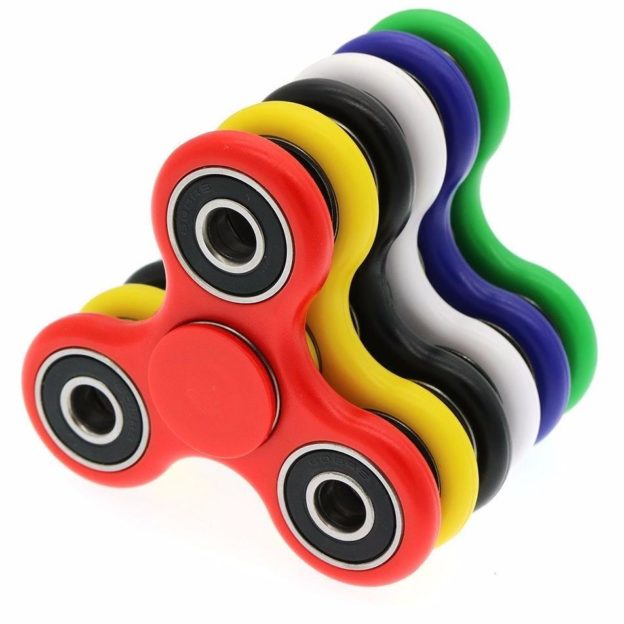This current season’s most blazing toy is promoted as an antitoxin for consideration shortfall hyperactivity issue, uneasiness — but at the same time it’s being prohibited in classrooms the nation over.
“Fidget spinners” are little, metal roller gadgets that the client can turn between his or her fingers. The force of the toy gives a satisfying tactile ordeal, as per client surveys, while the test of hurling, exchanging and whirling the spinners has produced a whole universe of instructional YouTube recordings which are spreading in many regions like fidget spinners in Bangladesh, fidget spinners in Pakistan and many more Asian countries.
Numerous spinners are promoted as associates for people with uneasiness, extreme introvertedness and ADHD; Cppslee’s spinner showcasing patter on Amazon, for instance, guarantees more prominent fixation for individuals with those conditions, in addition to a chance to “draw out that innovative virtuoso lying profound inside you.”
Unsurprisingly, these claims are probably overblown, scientists say.
“Utilizing a spinner-like gadget will probably fill in as a diversion than an advantage for people with ADHD,” said Mark Rapport, a clinical therapist at the University of Central Florida who has considered the advantages of development on consideration in individuals with ADHD.
(The alleged fidget shape — which is a plastic block furnished with different catches and dials for fidgeting hands — might be more classroom cordial, as indicated by a researcher who ponders crossing point of human PC association and recreations, who brought up on the site The Conversation that the solid shape doesn’t require visual consideration.
Despite their handiness in keeping children’s occupied brains centered, fidget spinners have started a discussion about abilities to focus in children and how to help the little ones’ concentration, specialists disclosed to Live Science. For example, however there isn’t a great deal of information supporting children have less concentration today than before, some exploration suggests abilities to focus have diminished as multitasking has expanded with the advanced age, one master said. There are different strategies for taking children’s concentration back to the current lesson, therapists say, including wriggling gadgets, action breaks and the basic expulsion of additional diversions. (The gadgets may likewise show kids something about material science, or possibly metal rollers.)
A trend erupts
Fidget spinners rose this spring, apparently suddenly, as an unquestionable requirement have contraption. Before December 2016, Google scans for the words “fidget spinner” were essentially nonexistent. Presently, educators are posting about their disappointments with spinner-fixated understudies on Twitter, and the toys even have their own particular gathering on Reddit.
A large portion of the debate encompassing fidget spinners has been over schools forbidding them from classrooms. A primary school important in Evanston, Illinois, Kate Ellison, told the Chicago Tribune that the spinners have been a diversion in classrooms in her school, and that youngsters with exceptional necessities have other, school-accommodating alternatives for wriggling. In the meantime, a few guardians of children with uncommon necessities have hailed the toys’ advantages. One blogger, a parent of an 8-year-old with a mental imbalance, composed on AutismAwareness.com that her little girl was excited to see her cohorts needing to fidget simply like her. School-endorsed fidget gadgets stamp her little girl as various, composed Miriam Gwynne, however fidget spinners are basically cool.
“For her, the fidget spinner is not an unquestionable requirement have furor to resemble her companions, yet more an anxiety discharge from the requests put upon her amid her school day — much the same as she utilizes an anxiety ball or her wind and-bolt squares,” Gwynne composed.
Spinner benefits?
There’s most likely toys that enable children to fidget would benefit be able to kids with extreme introvertedness. Word related advisors regularly utilize tangible toys like material plates, Koosh balls and even putties or muds to alleviate kids who have tactile handling issues. Likewise, inquire about has demonstrated that development would help be able to kids with ADHD to center. A recent report distributed in the Journal of Abnormal Child Psychology by Rapport and his associates taken a gander at 8-to 12-year-old children with ADHD. The scientists found that the individuals who taken an interest in action — meaning the development of appendages or expansive parts of the body — performed superior to anything the individuals who sat as yet amid errands including working memory, which is a sort of memory utilized for handling approaching data. Exercise has likewise been ended up being useful for kids with ADHD.
In any case, without ponders that particularly take a gander at fidget spinners, it’s difficult to state without a doubt whether the gadgets could help kids with ADHD, Rapport revealed to Live Science. He guessed that the little handheld toys are not liable to help much. They don’t require net body development, he stated, which is the thing that gives off an impression of being in charge of expanding action in the frontal and prefrontal cerebrum regions that are in charge of supporting consideration. The spinners are additionally outwardly diverting, thus they could pull a tyke’s consideration far from the blackboard or instructor, Rapport said.
“Riding a stationary bicycle while perusing, or sitting on a development ball while working at one’s work area, interestingly, permits little (non-diverting) engine developments and would presumably demonstrate gainful for some kids with ADHD,” Rapport wrote in an email to Live Science.
Spinner safety
An informal report in June about conceivable lead in these toys may have guardians stressed, however don’t clear your home of the spinners presently. Tamara Rubin, a lead-harming counteractive action advocate who is not associated with any college or research organization, home-tried 11 fidget spinners and discovered bizarrely high measures of lead in two of these. All things being equal, Rubin’s discoveries have not been imitated nor peer-assessed; and Rubin just tried 11 spinners. A greater concern might be the danger of children stifling on a portion of the spinner’s little parts.








